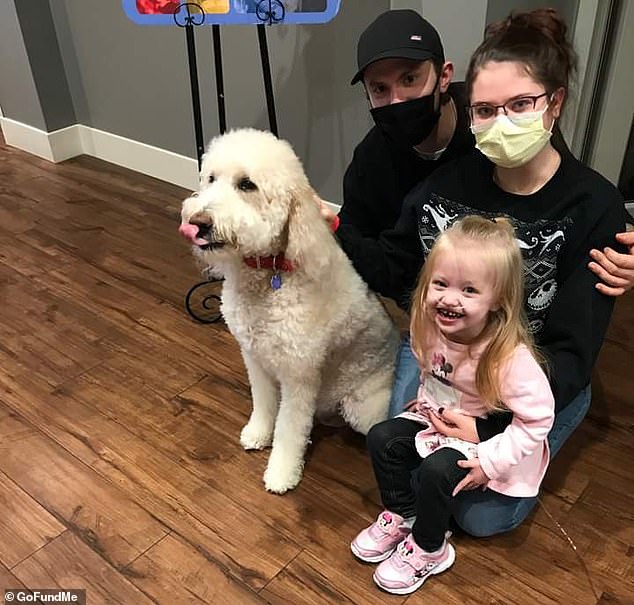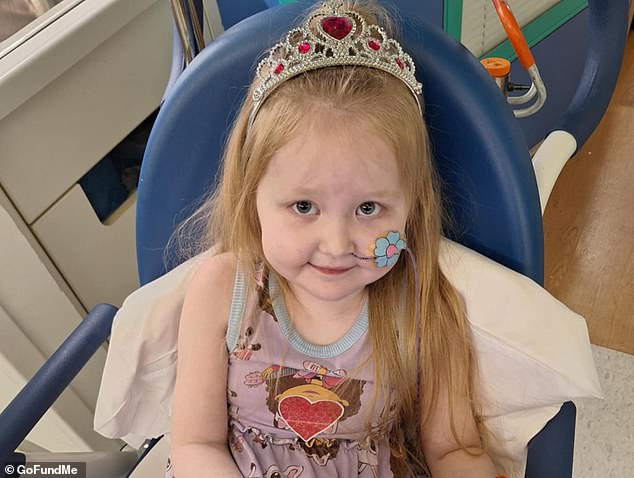Mississippi girl, 5, receives double lung transplant after rare condition turns her body blue
Harper Ryals lived a normal, healthy life until she turned two. Suddenly, the toddler experienced a massive growth spurt and began having difficulty breathing and developing a persistent blue tint to her skin.
Her mother, Rebecca Newman, a Mississippi housewife, took her to the doctor and discovered that large portions of the blood vessels in her lungs and brain were tangled and malformed, starving her body and organs of oxygen.
Harper, now five years old, was diagnosed with a rare disease called hereditary hemorrhagic telangiectasia (HHT). Approximately 75,000 people in the United States currently suffer from this disease.
Doctors discovered that Harper had an even rarer form of the disease, meaning that no traditional treatment would work to restore oxygen to the child’s body — short of a double lung transplant. Without such a transplant, she would die.
The genetic form of HHT that Harper is living with was declared end-stage, meaning she was in the final stages of a progressive disease, or just before her death. It is the updated medical term to use in place of ‘terminal’

Harper and her mother Rebecca Newman and father David Ryals took advantage of the Ronald McDonald House accommodations while in Arkansas for one of their many out-of-state doctor visits
She started suffering from severe, debilitating migraines due to the lack of oxygen to her brain and had little energy to get through the day because the oxygen circulation in her body was so low.
‘Without a transplant, the clock was ticking away for her life expectancy. She was constantly on extra oxygen,’ Ms. Newman said on a GoFundMe page for medical expenses.
HHT is a disease that affects the way blood vessels form. It can affect any part of the body.
Instead of the blood vessels forming separately and allowing blood to flow normally, in HHT they form tangled clumps called arteriovenous malformations, which can cause bleeding and blood clots.
This also reduces the amount of oxygen flowing through the body, which is what happened to Hayden, leading to her blue skin.
When HHT enters the lungs, it normally occurs in isolated areas rather than larger groups that surgeons can treat.
But Harper has a rare genetic form of HHT that causes many smaller clumps of malformed blood vessels to form throughout her lungs.
“It’s something that actually happens because of some insane astronomical chance in the conception process,” Ms. Newman said. Told TODAY.
Because the blood vessel problems in Harper’s lungs were so widespread, doctors could not perform surgery to correct individual blood vessels.
The only treatment would be to transplant her two new lungs. Doctors gave her no timeline, but declared her terminally ill, the updated terminology for terminal, meaning the disease would eventually kill her without treatment.
Lung transplants in children are still quite rare, with only a few dozen performed each year.
This is partly because it is difficult to find healthy donor lungs that match a recipient’s blood type and body size. In addition, the person who died to donate the lungs must not have suffered damage to the organs before passing them on to the recipient – making successful donation a rare event.
Dr. Tina Melicoff, medical director of the lung transplant program at Texas Children’s Hospital, where Harper was treated, told TODAY.com that these factors play a role and that many people have to wait a long time for a suitable lung.
“Even with those low numbers, the wait times can be very long, longer than for adults,” Dr. Melicoff said.
According to WHO, about 75 percent of lung transplant candidates in 2022 received the transplant within a year. Scientific Registry of Transplant RecipientsDuring that waiting period, approximately 13 percent died or were removed from the waiting list.
Harper was placed on the list in April.

Harper spent her fifth birthday recovering from the lung transplant in the intensive care unit at Texas Children’s Hospital
Before she was put on the transplant list, Harper and her family took a Make-A-Wish trip to New Orleans. There, the little girl contracted a virus and became terminally ill — she spent four months in the pediatric intensive care unit.
Finally, the family received news that a set of lungs was available for transplant. On June 15, she received a new set of lungs.
The transplant was a success. Ms. Newmann told TODAY she saw her baby’s skin color return — from blue to pink.
Still, the little girl still has a long way to go.
Mrs. Newman said her daughter would have to spend the rest of her life traveling to various specialists in Mississippi, Arkansas and Missouri to monitor other clots in her brain and make sure her new lungs were functioning properly.
Even with these setbacks, the little girl was set to start kindergarten soon. Her mother said that despite everything, Harper has remained a “fun, loving, energetic, smart, beautiful, and talented girl. She has the biggest heart of anyone I know and she is truly heaven-sent.”
